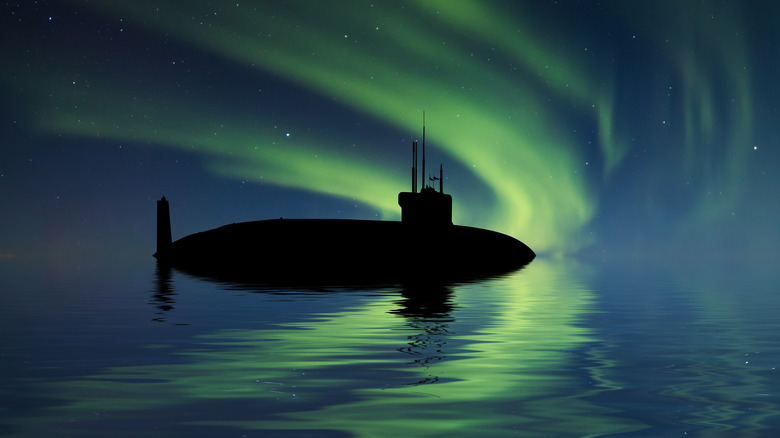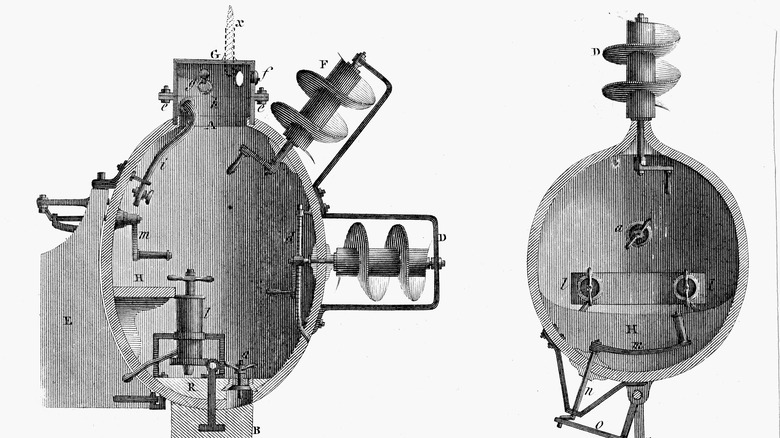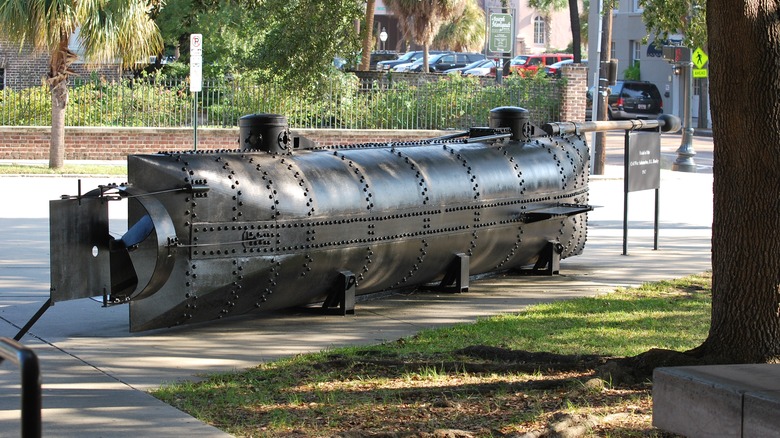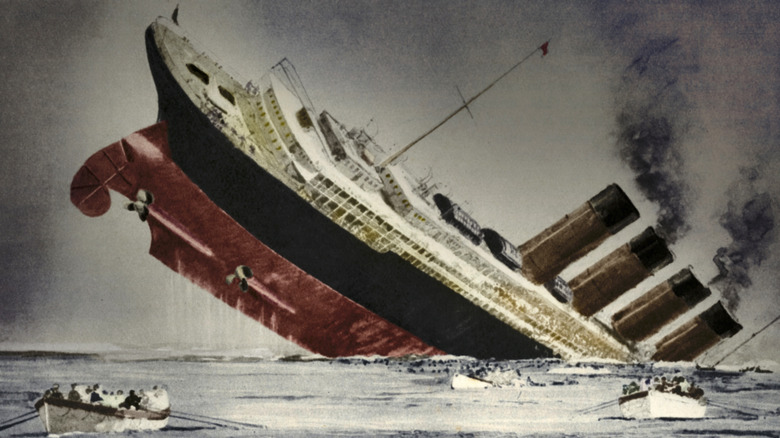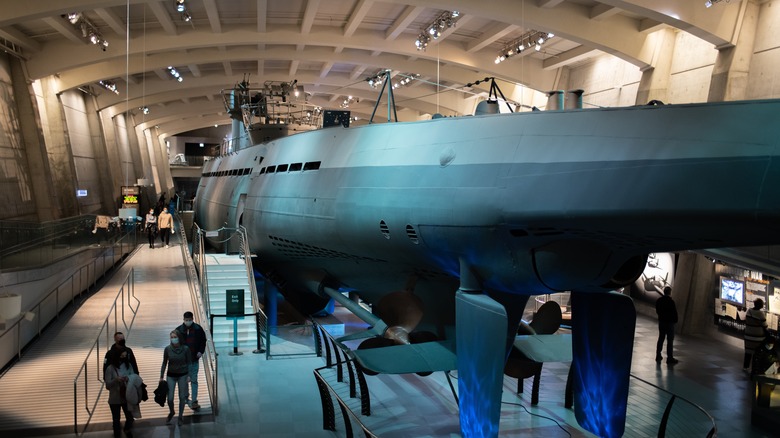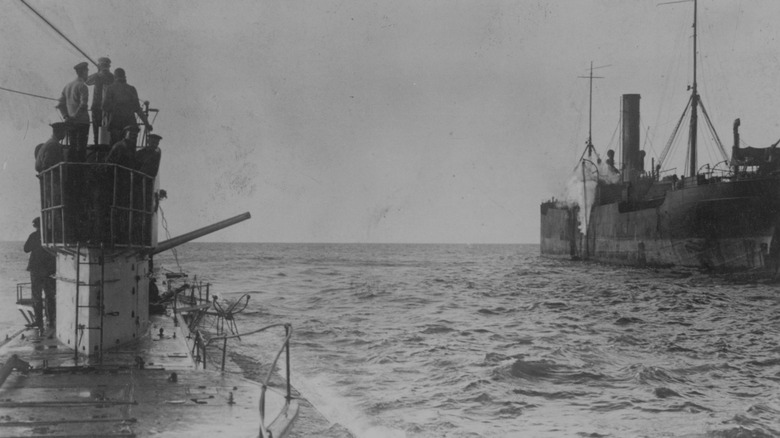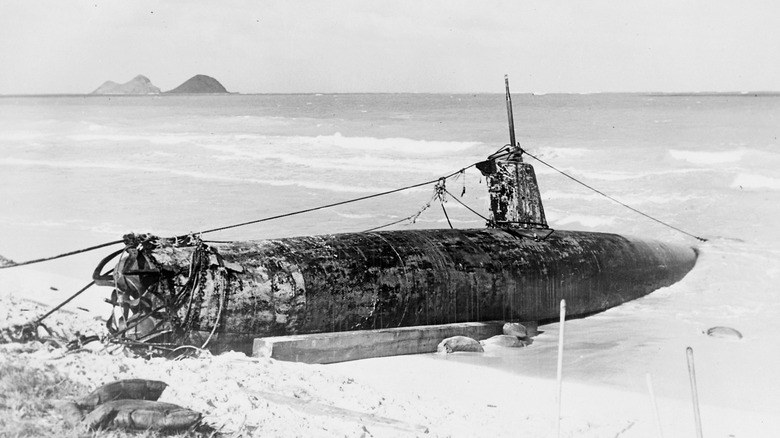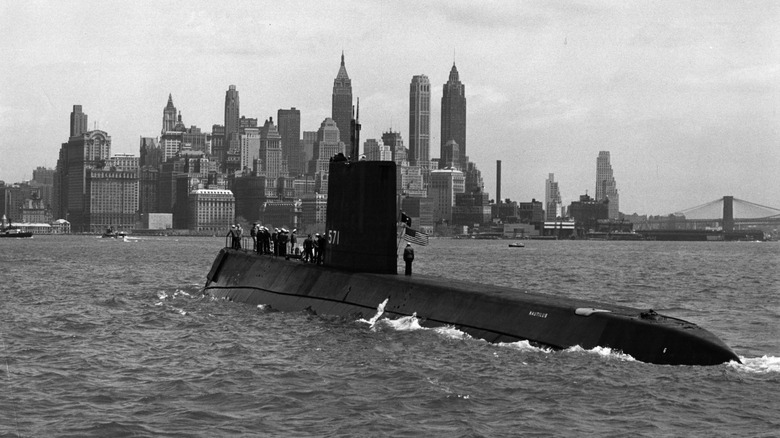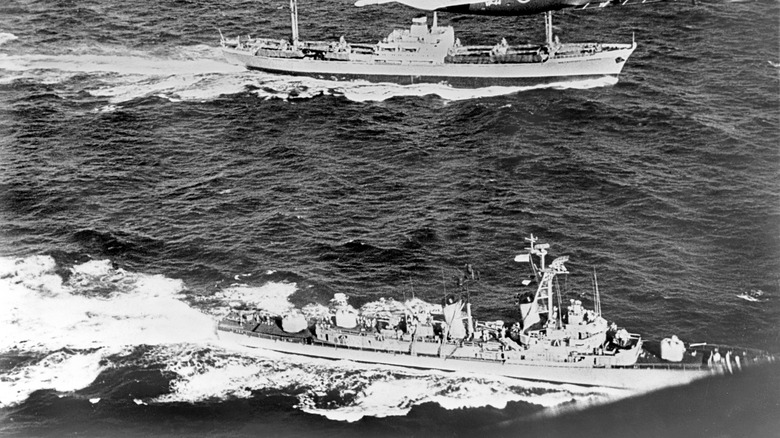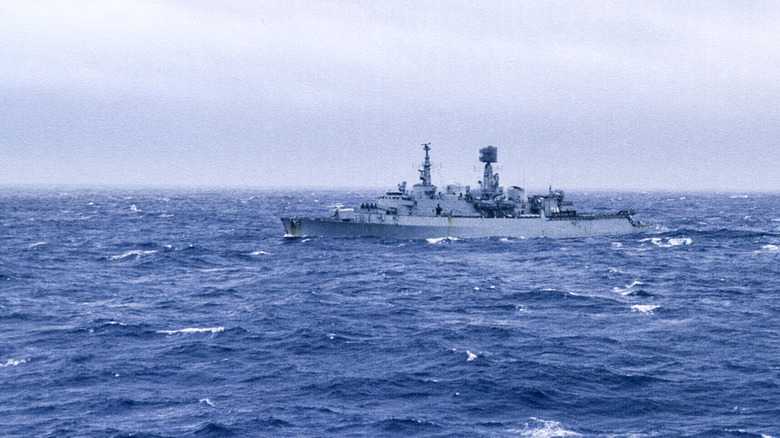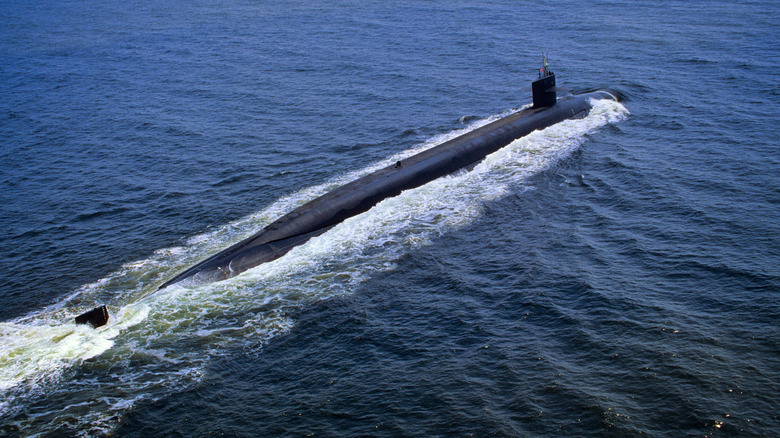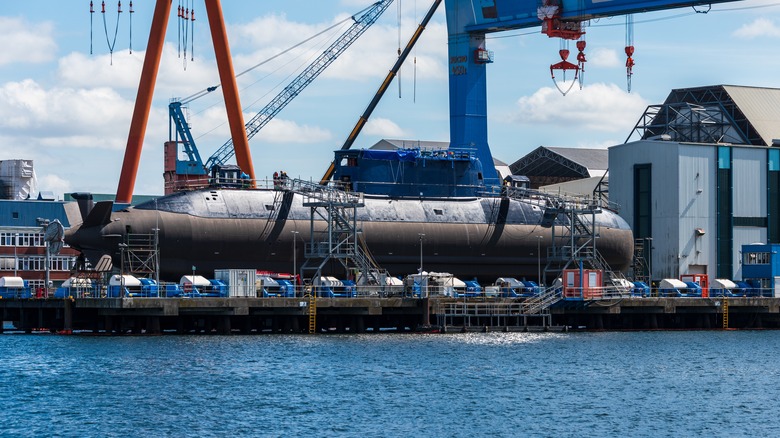11 Of The Most Historically Significant Submarines In Military History
"The only thing that ever really frightened me during the war was the U-boat peril," admitted Winston Churchill at the close of the world's most deadly conflict. Not the Blitz bombing campaign, not the Nazis occupying nearby France, but silent, lurking German submarines. 2,937 ships were sunk by German U-Boats during WW2 — per the Sunken Ships of the Second World War – and that statistic doesn't account for ships sunk by Allied submarines, nor the many, many ships sunk during World War I's unrestricted submarine warfare.
"Submarines are the Apex predators of maritime conflict," says James Goldrick, veteran and historian. They're terrifyingly difficult to detect and hunt down, which allows them to sneak past entire blockades, perform reconnaissance deep in enemy waters, lay sabotage, and then strike with decisive power without giving any warning — and they only got more fearful later on when they started carrying nuclear missiles.
The psychology at play above and below the water makes for some of history's most fascinating moments. Submarines have redefined warfare many times, ended wars, and even brought the entire world dangerously close to the brink. Today we look at 11 submarines that stick out on the historical record.
The Turtle — U.S. Revolutionary War sabotage machine
The first working submersible prototype was an invention of one Cornelius Drebbel in 1620, which he cooked up for the British Navy. It worked, but never caught on. About 150 years later, the American Revolution made history by being the first to deploy a submarine in combat, albeit classified as a Waters Machine at the time. David Bushnell and Isaac Doolittle had been working on a timed bomb that could be detonated underwater. To deliver the bomb, they concocted the "American Turtle, or simply The Turtle, a Waters Machine that could only carry a single operator with no auxiliary oxygen.
The Americans needed a way to drive the British Navy out of New York Harbor, and so they sent Ezra Lee to pilot the Turtle under cover of night on September 6, 1776. His mission? Blow up the British HMS Eagle by attaching a powder keg to the underside of its hull. The mission was unsuccessful; Lee's augur struck metal instead of wood, forcing him to abandon the bomb and retreat. Regardless, this unsuccessful sabotage proved that an underwater vessel had promise.
This wasn't the last of the Turtle's service. The revolutionaries deployed it two more times, failing to attach the bomb just as the first. The Turtle was then sunk at the Battle of Fort Lee, never to be recovered. Today, you can see a replica of this unforgettable slice of history at the Connecticut River Museum.
H.L. Hunley — The first submarine to sink an enemy vessel
The Civil War was more technologically advanced than you might believe. It was the first armed conflict to include an "aircraft carrier", and the first where a submarine sank an enemy vessel. The H.L. Hunley was built in 1863 for the American Confederacy, financed by Horace Hunley. It was constructed out of rolled iron boiler plate, with a hand-operated crank screw, hand-pumped water ballast tanks, diving planes, and even the iconic conning tower that is integral to every submarine to this day.
Despite its impressive engineering, the H.L. Hunley was more a tomb than a ship. It sank two times before active service, killing most of the crew and Hunley himself. This didn't deter the Confederacy, and they deployed the Hunley once more on February 17, 1864, this time with a "spar" torpedo. Unlike modern torpedoes, this one was effectively a copper-coated explosive mine attached to the sub by a long pole, which required the Hunley to ram a ship for effect.
That night, the Hunley mortally wounded the Union's USS Housatonic, yet the Hunley mysteriously went down with it. The mystery only grew when the ship was recovered in 1995 and it was discovered that the crew had not activated any of the failsafes available to help them escape in an emergency. After years of painstaking examination, researchers in a 2017 Nature study concluded that the shockwave from the torpedo went through the submarine, sinking it and killing the crew in one fell swoop. You can see the real Hunley for yourself on display at the Hunley Museum.
U-20 — The World War I German U-boat that sank Lusitania
It was World War I where submarines really hit their stride, particularly with top-of-their-class German U-Boats, or Unterseeboot. Submarines were primitive compared to the underwater fortresses we have today, as sailors lived in cramped conditions, suffocated by diesel fumes, and were unable to shower. Despite this, the U-Boats were terribly effective, and on February 4, 1915, the Germans began a campaign of unrestricted submarine warfare — in other words, sinking any ship they found without warning. Shortly after, one of the greatest tragedies of World War 1 happened — the sinking of the Lusitania.
U-boat U-20 pulled a surprise attack on the Lusitania on May 7, 1915, resulting in the deaths of 1,195 innocent passengers. For comparison's sake, the sinking of the Titanic is believed to have ended the lives of 1,500 people. Needless to say, this was an unforgivable tragedy regardless of a person's political alliance. The Germans initially defended their decision on the grounds that the Lusitania had been hauling munitions, but after they sank the Arabic on August 19th (another passenger ship), they were pressured from all sides to walk back their policy in September 1915.
Sadly, the Arabic was not the last, and by February 1917, unrestricted submarine warfare went back into full swing — at one point sinking 13 ships a day — until the close of the war in 1918.
U-48 — The most successful World War II German U-boat
In order to halt German aggression after World War I, the Treaty of Versailles severely restricted the country's military might and completely forbade submarines. To get around this, the Germans used a Dutch shell company to furtively build submarines for other nations, thus improving their designs and setting the stage for their dominance once war began anew.
By 1940, unrestricted submarine warfare on merchant shipping lanes was back, this time with far more advanced U-boats. U-Boat wolf packs became the nightmare of the Atlantic, attacking woefully under-equipped convoys and sinking around eight ships per month, per submarine. U-48 was the most successful of the German Navy (and one of the most successful of all time), with sources estimating that it sent at least 51 ships (some sources say 57) to a watery grave. It then left active service to be used as a training vessel in 1941.
U-48's career is emblematic of how fraught it was to crew these subs. Accounts tell of how it was hunted and struck with depth charges on multiple occasions, somehow always slithering out unscathed. In fact, there are no known crew casualties on U-48, and it's believed the U-48 wore a cat emblem — as in, a ship with nine lives. After 12 patrols, the navy determined that U-48 was too outdated to serve effectively, evidence of how submarine technology was improving even in the heat of war. The ship was scuttled in 1945.
U-110 — The U-boat capture that helped crack Enigma
The film "U-571" tells the daring story of U.S. sailors pretending to be Germans in order to steal an Enigma machine from a U-boat. Enigma was the Germany's encrypted cypher machine, alter ego to the Allies' superior SIGABA. There's just one problem: "U-571" is widely regarded as one of the most historically inaccurate World War II movies ever. U-571 is the wrong boat, it was British (not Americans) who took it, and the movie takes place after the Enigma was well on its way to being broken and is set months before the U.S. got involved in the war. That said, there was indeed a German submarine captured by Allied powers with the key to cracking Enigma.
During Operation Primrose on May 9th, 1941, the HMS Bulldog had been with a convoy of ships when there was a surprise attack by German subs. Hit by depth charges, U-110 surfaced and her crew abandoned ship. Then Gunnery Control Officer David Balme — the real hero of this story — boarded U-110. He and the boarding party captured an Enigma machine, codebooks, anything they could get as the waves were crashing on the sinking U-110 and depth charges from the battle around them were threatening to crack her hull.
Balme got lucky when the detonators on the scuttling charges set by the German crew to sink U-110 had failed. In addition to codebooks that later became necessary to crack Enigma, Balme also stumbled upon grid charts labeling U-boat and minefield locations. The best part? Balme later saw the film "U-571," twice. "It's a great film," he admitted to BBC News. "It's all blood and thunder and the young people will love it."
Japanese Midget submarines — An unknown prong of the Pearl Harbor raid
Everyone knows that the Pearl Harbor was an airborne raid on Hawaii, but not everyone realizes that submarines took part as well. Japan had a bunch of so-called "midget" submarines. They weighed less than 150 tons, had limited range, but were harder to detect on sonar and could navigate shallower water than normal subs. The Japanese Empire sent in midget submarines to sink even more ships during Pearl Harbor as the airplanes attacked from above. However, only one midget sub reached the harbor and was sunk prematurely before the raid.
That morning, American sailors spotted a conning tower. The U.S.S. Ward pursued and sank it at 6:45 AM. Sadly, this military action somehow didn't get up to U.S. high command. Supposedly, this was because officers were still at breakfast, and personnel had been desensitized by false-alarm submarine spottings in previous weeks. So at 7:55 AM Pearl Harbor kicked off, a total surprise that took over 2,400 American lives. Despite the earlier failure, it's rumored that one midget sub did actually land a torpedo strike during the attack.
Alas, the midget subs were plagued with problems. None of them returned home, and one even washed up on the beach the day after. Midget subs continued to take part in the Pacific Theater, although their trend of failure never really improved. They were seen at Sydney and Guadalcanal, with some even being found in the Aleutians near Alaska.
USS Nautilus — The first nuclear-powered sub
Submarines during World War II were the terror of the ocean, but they weren't without their share of limitations. They used diesel engines, which forced them to surface regularly for fuel and air — air for both crew members and the engine, meaning a sub couldn't stay underwater for long. That changed with the first-ever nuclear sub, the USS Nautilus.
The U.S. Navy launched the Nautilus in 1954, and since nuclear reactors require no oxygen, it could (theoretically) remain underwater for longer than was practically necessary. The feather in the Nautilus' cap was being the first to go under the North Pole's ice pack, a once-impossible feat because of diesel engines' tendency to freeze. Aside from that, she did her duty as a Navy ship.
Submarines were already haunting effective prior to this advancement, so when they could slip beneath the waves seemingly forever, the face of modern warfare changed to compensate. They became lethal hunter-killers, and mobile launch platforms for intercontinental ballistic missiles (ICBMs), turning them into a vital check and balance during the Cold War. The enemy doesn't dare launch their nuclear missiles (and neither do you) because their (or your) nuclear-powered submarines could be anywhere, at any time, ready to launch a retaliatory second strike.
Russian B-59 — The submarine that almost started World War III
You've probably heard at least a couple of stories of when the U.S. and the Soviet Union came within inches of leaving the world a smoking ruin under the brume of nuclear winter. Launching nukes is easy when human beings are so fallible.
Such an episode very nearly happened during the Cuban missile crisis, and it hinged on a Soviet submarine. The Soviet Union was trying to put nuclear missiles on Cuba to keep the U.S. in check. There was a heated back-and-forth combined with a U.S. quarantine of the island blocking Soviet ships, but the Soviet Union eventually backed down and removed their missile sites. During that sweaty-palmed moment in history, though, Soviet sub B-59 had only one person stopping it from torpedoing a U.S. ship.
Vox sets the tense scene incredibly well: the lone submarine was surrounded, evading depth charges from 11 US destroyers, and underwater for so long that it had no contact with high command and dwindling oxygen. All it needed was unanimous agreement from three officers (the Kremlin didn't even need to be asked) to launch its 10-kiloton torpedo and take down at least one ship with it. Two officers had fingers on the trigger. One did not: second captain Vasili Arkhipov. He correctly divined that the depth charges weren't to sink B-59, they were warning shots to get it up to the surface — likely because he'd seen American ships signaling before the dive.
His stalwart holdout possibly saved us all, and B-59 retreated home with its nuclear torpedo unspent. Thereafter the Cold War went back in the freezer.
HMS Conqueror — The only cold war nuclear sub sinking
Surprisingly, there was only one incident in history where a nuclear sub sank a vessel: the British HMS Conqueror torpedoing the Argentinian ARA General Belgrano in 1982. This was during the short-lived Falklands War, where Argentina invaded the Falkland Islands to wrest it away from the British. The British Empire had forcefully occupied the territory in the first place in 1833.
Tensions rose when, after Argentinian forces took the islands, the British drew a Total Exclusion Zone in a wide circle around the area and deployed a task force to retake their claim. The Argentine junta sent three naval groups to stop them. The British were stretched thin and without reinforcements. All it would take was one losing skirmish and they'd forfeit the territory forever. So, the HMS Conqueror put two torpedoes in the ARA General Belgrano, sinking it and leading to over 300 casualties. This bad omen spooked Argentinian forces so badly they withdrew. One might argue, therefore, that a single submarine ended the Falklands War.
This decision was highly controversial. Some believed the HMS Conqueror acted within reason since, allegedly, Belgrano Captain Hector Bonzo had orders to sink any British ships. Others believed that the attack was disproportional and a war crime. In any case, it certainly smacked of post-colonialist Britain trying desperately to cling to the far-flung territories of its crumbling empire.
Ohio-class submarines — The rise of SSBNs and SSGNs
Right now, the kingfisher submarine of the ocean is undoubtedly the Ohio-class SSBN (SS for submarine, B for ballistic, N for nuclear). The U.S. has 14 of them, each packing 20 Trident II D5 SLBMs (submarine-launched ballistic missiles) according to SUBPAC, and some as many as 25 torpedoes (via CNN). Though they could theoretically last much, much longer (even being submerged), the Ohios go out for periods of 77 days at a time and exist primarily as a mobile nuclear deterrent.
A close sister to SSBNs are SSGNs, which have guided missiles instead of ballistic ones. They're the exact same Ohio-class design, albeit repurposed. They carry a payload of up to 154 Tomahawk cruise missiles. In both cases, they have two sets of alternating crews that allow them to run 24/7. Remember, these are an incredibly effective tool at keeping foreign enemies from pressing the big red button since the location of these subs (aside from their ports of call) is a closely-guarded secret. To emphasize that point, keep in mind that SSBNs carry 70% of the US' is nuclear arsenal.
Columbia-class submarines — the next generation of submarine warfare
The Ohio-class submarines are certainly terrifying, but they are "old" by military standards. We built them from 1981 to 1997. Though that makes the youngest Ohio subs technically Gen Z, military hardware ages a lot faster than us humans. The Ohio-class will enter a well-deserved retirement starting 2027. To replace it, the US Navy has already commissioned the next generation of SSBNs, bigger even than the massive Ohio: the Columbia-class.
According to Submarine Industrial Base Council, 12 new Colombia-class SSBNs will serve for 42 years apiece, featuring reactor advancements, 16 missile tubes (in keeping with START requirements), and upgraded Trident II SLBMs. These ships will also have upgraded stealth capabilities, better torpedoes, and a more sophisticated electric drivetrain, among other general improvements.
There's an element of cost cutting here, too. According to Congressional Research Service, Columbia-class subs will take incrementally less to build year over year, with a plan to build one per year. Replacing the fleet has become a top priority for the Navy, perhaps especially with China racing to make its own SSBN competitor.
